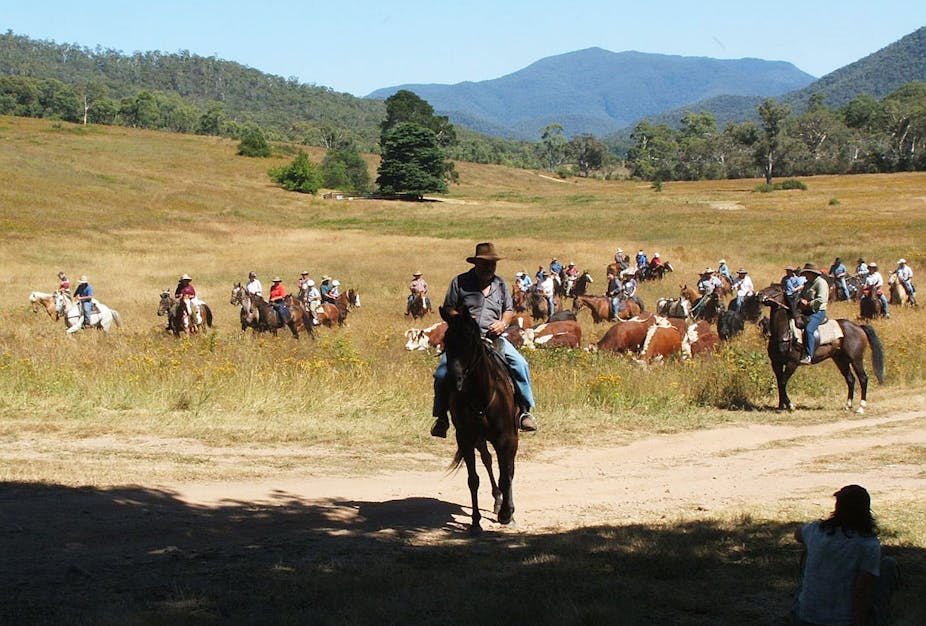The Victorian government has removed cattle from the Alpine National Park and introduced legislation to parliament that bans future cattle grazing in the park, under debate this week. This is the latest in a string of decisions relating to alpine grazing in Victoria.
We are now back where we were a decade ago, when the Labor government under Steve Bracks banned cattle grazing in the Alpine National Park in 2005.
So, what is the crux of this debate? Those in favour of alpine cattle grazing argue that “grazing reduces blazing” – that it lessens the risk of fire.
Opponents point to the lack of evidence for this claim and the ample evidence that cattle grazing harms the environment. The science supports the position of the opponents.
But to understand the current situation, it is worth recalling the cycle of policy changes over the past decade.
More politics than science
In 2005, the Bracks government prohibited cattle grazing licences in the Alpine National Park, citing environmental impacts, costs, and lack of benefits.
In 2010, the Liberal-National government won office by one seat, including the seat of Gippsland East. Winning that seat was helped by a promise to reintroduce cattle grazing to the Alpine National Park, securing the backing of the Mountain Cattlemen’s Association of Victoria, a locally influential group.
However, the new government faced a problem. The option to license cattle grazing in the park was no longer available to the government. Instead, the government chose to begin a scientific trial on the effects of cattle grazing on fire risk. National parks in Victoria can be legitimately used for science.
Eyebrows were raised when the cattle were released into the park within months of the government gaining office and in the full knowledge of the Mountain Cattlemen’s Association, but to the apparent surprise of the scientist nominated by the government to assist with the trial.
The absence of baseline data collection or data collection while the cattle were in the park, suggestions to “manage” scientists who were critical of the grazing, and broad concern across the scientific community, all fed the impression that this was simply cattle grazing and politics, and that it had little if anything to do with science.
In and out of the park
The Victorian government’s problems didn’t stop there. The federal environment minister at the time, Tony Burke, ruled that the grazing trial should have been referred under the Environmental Protection and Biodiversity Conservation (EPBC) Act, and ordered the cattle out of the park.
The cattle were due to be removed soon anyway with the impending winter, but after a subsequent referral, Tony Burke ruled that the planned cattle grazing would have unacceptable impacts, and the cattle would not be allowed to return the following summer. This position was maintained when the Victorian government’s bid in the Federal Court to have that decision reconsidered failed.
While the Victorian government had been thwarted, the change of federal government in 2013 offered a new dawn. A scaled-back trial was approved by the new federal government, and cattle were returned to a small low-elevation section of the park in the summer of 2013/14.
But the new dawn was short-lived. With the return of a Victorian Labor government in the 2014 state election, the cattle were removed from the park.
What have we learned?
Well, probably nothing new on the science front. While the cattle and concerned stakeholders might have become dizzy on the political roundabout of grazing in the Alpine National Park, the science remained consistent.
There is no evidence that cattle grazing reduces forest fire risk in the Park, but there is ample evidence that it harms the environment.
Advocates of cattle grazing in the Alpine National Park identify with strong historical and cultural links to the practice. These values are valid regardless of how cattle influence fire.
Opposed to these views are those who are validly concerned about the negative environmental impacts of cattle in protected areas.
Science can never resolve these different points of view, because they relate largely to different values, not to questions of data or evidence. While any trial about the effects of cattle grazing on fire risk might provide further evidence of scientific interest, it seems unlikely that it would reconcile the different values that are placed on alpine cattle grazing.
There is no doubt that Victoria faces fire risks that need to be addressed. Science can help identify areas at high risk of burning, and identify where these areas intersect with the things society cares about – human lives, infrastructure and the environment for a start.
Science can help assess any trade-offs between these values. Ultimately it is the government’s role to capture these values, and make the difficult trade-offs about where fire management resources are best spent.
But were Victoria’s fire management resources best spent resolving uncertainty about the impact of grazing in the Alps? Does this help us make better decisions about fire management in Victoria?
Probably not: the planned trial had very little chance of telling us anything meaningful about fire risk across the Alps because of its design, size and context limitations. In the case of alpine grazing, arguing about the science was a distraction that potentially wasted valuable time and resources.

